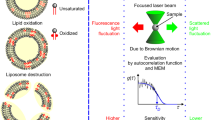Abstract
Catechin molecules are known to reduce the oxidative stress-induced by radiation acting as scavenger of the reactive oxygen species, preventing in this way the damage in biomolecules. In this work, the effect of radiation on liposomes of 1,2-dipalmitoyl-sn-glycero-3-[phospho-rac-(1-glycerol)(sodium salt) (DPPG) and of 1,2-dimyristoyl-sn-glycero-3-phosphocholine (DMPC) is analyzed in the absence and presence of epigallocatechin-3-gallate (EGCG) molecules, having in view the evaluation of the photosensitizing properties and the efficacy of these molecules to modulate cell membrane damage mechanisms. The obtained results demonstrate that the damage by UV radiation on DPPG and DMPC liposomes is strongly dependent of the presence of EGCG molecules. While DPPG liposomes are protected from radiation in presence of EGCG, the EGCG molecules are damaged by the radiation supporting the idea that EGCG are strongly adsorbed on the inner and outer liposome surfaces due hydrogen bonding. This suggests that EGCG molecules in the inner surface can be protected from radiation. In the case of DMPC liposomes, the EGCG molecules are affected by radiation as well as the DMPC molecules. This is explained if the EGCG chroman group is positioned between DMPC lipids while the gallic acid groups float over the liposomes.
Access this chapter
Tax calculation will be finalised at checkout
Purchases are for personal use only
Similar content being viewed by others
References
Lee, W.J., Shim, J.-Y., Zhu, B.T.: Mechanisms for the inhibition of DNA methyltransferases by tea catechins and bioflavonoids. Mol. Pharmacol. 68, 1018–1030 (2005)
Shankar, S., Ganapathy, S., Hingorani, S.R., Srivastava, R.K.: EGCG inhibits growth, invasion, angiogenesis and metastasis of pancreatic cancer. Front. Biosci. 13, 440–452 (2007). A journal and virtual library
Isemura, M., et al.: Tea catechins and related polyphenols as anti-cancer agents. Biofactors 13, 81–85 (2000)
Ross, J.A., Kasum, C.M.: Dietary flavonoids: bioavailability, metabolic effects, and safety. Ann. Rev. Nutr. 22, 19–34 (2002)
Ottova-Leitmannova, A.: Advances in Planar Lipid Bilayers and Liposomes, vol. 4. Elsevier/Academic Press (2006)
Santos, H.A., Vila-Vicosa, D., Teixeira, V.H., Baptista, A.M., Machuqueiro, M.: Constant-ph MD simulations of DMPA/DMPC lipid bilayers. J. Chem. Theor. Comput. 11, 5973–5979 (2015)
Vila-Vicosa, D., Teixeira, V.H., Santos, H.A., Baptista, A.M., Machuqueiro, M.: Treatment of ionic strength in biomolecular simulations of charged lipid bilayers. J. Chem. Theor. Comput. 10, 5483–5492 (2014)
Hugot, S., Sy, D., Ruiz, S., Charlier, M., Spotheim-Maurizot, M., Savoye, C.: Radioprotection of dna by spermine: a molecular modelling approach. Int. J. Radiat. Biol. 75, 953–961 (1999)
Gomes, P.J., Ribeiro, P.A., Shaw, D., Mason, N.J., Raposo, M.: UV degradation of deoxyribonucleic acid. Polym. Degrad. Stab. 94, 2134–2141 (2009)
Gomes, P.J., Coelho, M., Dionísio, M., António Ribeiro, P., Raposo, M.: Probing radiation damage by alternated current conductivity as a method to characterize electron hopping conduction in DNA molecules. Appl. Phys. Lett. 101, 123702 (2012)
Gomes, P., et al.: Energy thresholds of DNA damage induced by UV radiation: an XPS study. J. Phys. Chem. B 119, 5404–5411 (2015)
Moraes, M.L., et al.: Polymeric scaffolds for enhanced stability of melanin incorporated in liposomes. J. Colloid Interface Sci. 350, 268–274 (2010)
Duarte, A., et al.: Characterization of PAH/DPPG layer-by-layer films by VUV spectroscopy. Eur. Phys. J. E Soft Matter 36, 9912 (2013)
Duarte, A.A., et al.: DPPG liposomes adsorbed on polymer cushions: effect of roughness on amount, surface composition and topography. J. Phys. Chem. B 119, 8544–8552 (2015)
Polewski, K., Kniat, S., Slawinska, D.: Gallic acid, a natural antioxidant, in aqueous and micellar environment: spectroscopic studies. Curr. Top. Biophys. 26, 217–227 (2002)
Lin, X.-Q., Li, F., Pang, Y.-Q., Cui, H.: Flow injection analysis of gallic acid with inhibited electrochemiluminescence detection. Anal. Bioanal. Chem. 378, 2028–2033 (2004)
Ari, T., Güven, M.H.: Valence-shell electron energy-loss spectra of formic acid and acetic acid. J. Electron Spectrosc. Relat. Phenom. 106, 29–35 (2000)
Barnes, E.E., Simpson, W.T.: Correlations among electronic transitions for carbonyl and for carboxyl in the vacuum ultraviolet. J. Chem. Phys. 39, 670–675 (1963)
Xu, K., Amaral, G., Zhang, J.: Photodissociation dynamics of ethanol at 193.3 nm. J. Chem. Phys. 111, 6271–6282 (1999)
Satyapal, S., Park, J., Bersohn, R., Katz, B.: Dissociation of methanol and ethanol activated by a chemical reaction or by light. J. Chem. Phys. 91, 6873–6879 (1989)
Wen, Y., Segall, J., Dulligan, M., Wittig, C.: Photodissociation of methanol at 193.3 nm. J. Chem. Phys. 101, 5665–5671 (1994)
Pawlikowska-Pawlęga, B., et al.: Localization and interaction of genistein with model membranes formed with dipalmitoylphosphatidylcholine (DPPC). Biochimica et Biophysica Acta (BBA)-Biomembranes 1818, 1785–1793 (2012)
Phan, H.T., et al.: Structure-dependent interactions of polyphenols with a biomimetic membrane system. Biochimica et Biophysica Acta (BBA)-Biomembranes 1838, 2670–2677 (2014)
Acknowledgments
This work was supported by the Portuguese research Grant UID/FIS/00068/2013 by the project PTDC/FIS-NAN/0909/2014 through FCT-MCTES, Portugal. Filipa Pires acknowledges the fellowship PD/BD/106036/2015 from RABBIT Doctoral Programme (Portugal).
Author information
Authors and Affiliations
Corresponding author
Editor information
Editors and Affiliations
Rights and permissions
Copyright information
© 2017 Springer International Publishing AG
About this paper
Cite this paper
Pires, F., Magalhães-Mota, G., Ribeiro, P.A., Raposo, M. (2017). Effect of UV Radiation on DPPG and DMPC Liposomes in Presence of Catechin Molecules. In: Bracciali, A., Caravagna, G., Gilbert, D., Tagliaferri, R. (eds) Computational Intelligence Methods for Bioinformatics and Biostatistics. CIBB 2016. Lecture Notes in Computer Science(), vol 10477. Springer, Cham. https://doi.org/10.1007/978-3-319-67834-4_14
Download citation
DOI: https://doi.org/10.1007/978-3-319-67834-4_14
Published:
Publisher Name: Springer, Cham
Print ISBN: 978-3-319-67833-7
Online ISBN: 978-3-319-67834-4
eBook Packages: Computer ScienceComputer Science (R0)




